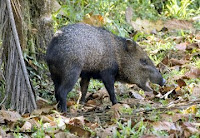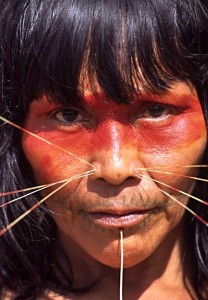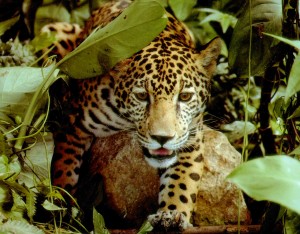In the Amazon, plants and animals are ascribed the status of persons, who may differ corporeally from human persons but, like them, possess intentionality and agency. Indeed, other-than-human persons are believed to see themselves in human form, and thus to be self-aware of their own personhood.
 |
Among the Ashéninka, for example, a white-lipped peccary is held to perceive its own herd as a foraging human tribe, its wallow as a human village, and the wild root it eats as cultivated manioc. A peccary sees a human hunter as a jaguar; a jaguar sees its human prey as a peccary, and sees other jaguars as humans. Similarly, among the Machiguenga, humans see themselves as humans; but the moon, the snake, the jaguar, and the mother of smallpox see humans as tapirs or peccaries that they hunt and kill.
These percepts extend to all aspects of culture: animals see their fur, feathers, claws, and beaks as body decorations and cultural instruments, and their social system as organized in the same way as human institutions. In a series of influential articles, Viveiros de Castro has called this theory of the world perspectivism, and has explicitly tied it to theories of animism.
 |
In the Amazon, this idea is almost always associated with another — that the visible form of every species is an envelope, a form of clothing, that conceals an internal human form visible only to other members of the same species, or to a shaman. This clothing is changeable and removable; in the Amazon, not only do shamans become jaguars, but also humans and animals constantly shift into each other, in what anthropologist Peter Rivière has called a “highly transformational world.”
Interestingly, humans put on animal clothes and turn into animals, and animals take off animal clothes and turn into humans; but animals never put on human clothes. All beings are human — which is just how they see themselves. “The common condition of humans and animals,” says Viveiros de Castro, “is humanity, not animality.” As Piro shaman don Mauricio Roberto Fasabi says of the kachpero, the strangler fig: “We see the kachpero as a tree, but that is a lie, the kachpero is a person. We just see it as a tree. When we take ayahuasca, we see it as people.”
 |
This is the animist matrix of the Amazonian shaman — as Viveiros de Castro puts it, an “intentioned universe.” Shamans — including my own teachers don Roberto Acho and doña María Tuesta — develop relationships with powerful beings even in the form of stones. This animism is not necessarily benign; social anthropologist Carlos Fausto calls it predatory animism. “Subjectivity is attributed to human and nonhuman entities,” he writes, “with whom some people are capable of interacting verbally and establishing relationships of adoption or alliance, which permit them to act upon the world in order to cure, to fertilize, and to kill.”
It is in this context, too, that we should look at the claim the people in the Amazon believe that shamans turn into jaguars; rather, jaguars, beneath their jaguar clothing, are already shamans. The ferocity of the jaguar is not due to its being an animal, but due to its being a human.

- Previous Post: Ayahuasca: National Cultural Heritage
- Next Post: Classifying Plants
- More Articles Related to: Indigenous Culture, Shamanism, The Amazon



Native Americans and other indigenous peoples, from my research and experience, also ascribe plants and animals a “consciousness” and intentionality. Although they are not as explicit perhaps. Interesting take on the jaguar/shaman shape-shifting.
I think you are absolutely right about indigenous peoples in general ascribing personhood to plants, animals, stones, and stars; take a look at my post here. It is less clear to me how extensively — if at all — perspectivism, as discussed here, is found outside the Amazon. I would be grateful for any further information. Thanks for your comment!
as i understand it, the lakota phrase,”mitake oyasin” or “all my relations”, is talking about this “personhood” that exists in all things.
according to the lakota shaman, matt lee, who practices a 400-year old tradition, everything is alive, “the rocks are the oldest of all, our grandfathers”, and, everything is sacred. he speaks of the different animal nations in the same way as he would nations of people. entering the sweat lodge, you say “mitake oyasin” and kiss the earth, as you crawl in at the low doorway.
Richard Nelson, in Making Prayers to the Raven: A Koyukon View of the Northern Forest, makes much the same argument. I would tend to agree with both of the other comments on your article.